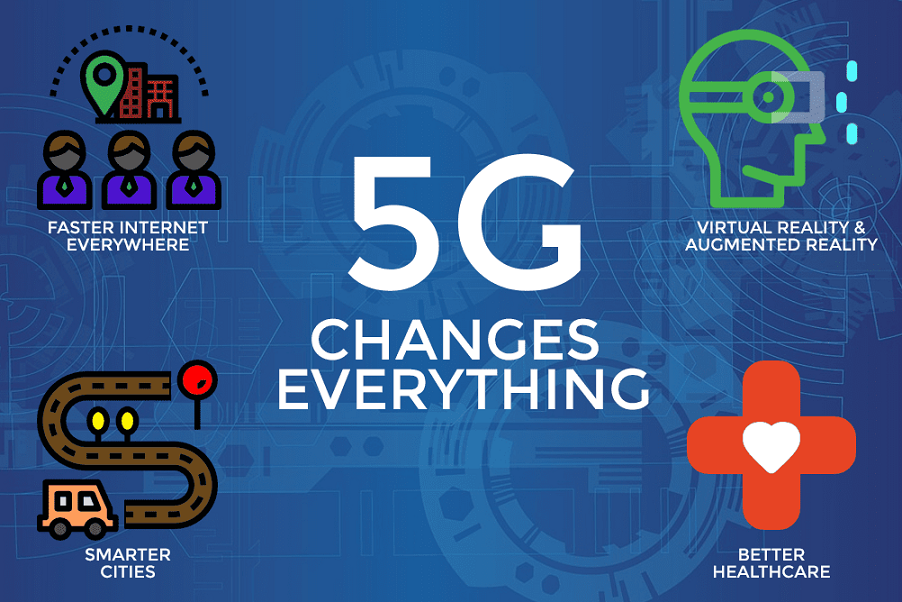Introduction
The advent of 5G technology is revolutionizing the digital landscape, bringing faster speeds, lower latency, and enhanced connectivity. As the fifth generation of mobile networks, 5G goes beyond just improving internet speeds; it is transforming industries, enabling smart cities, and paving the way for innovations in healthcare, transportation, and entertainment.
This article explores how 5G is reshaping various sectors, its key benefits, challenges, and what the future holds for this game-changing technology.
Understanding 5G: What Makes It Different?
To appreciate the impact of 5G, it’s important to understand how it differs from previous generations:
| Network Generation | Key Features |
|---|---|
| 1G (1980s) | Analog voice communication, basic connectivity. |
| 2G (1990s) | Digital voice calls, SMS messaging. |
| 3G (2000s) | Mobile internet, multimedia messaging, video calling. |
| 4G (2010s – Present) | High-speed internet, streaming, online gaming. |
| 5G (2020s – Future) | Ultra-fast speeds, low latency, massive IoT connectivity. |
With data speeds up to 100 times faster than 4G and response times as low as one millisecond, 5G is set to enable real-time communication on an unprecedented scale.
Key Benefits of 5G
1. Blazing-Fast Internet Speeds
- Download speeds exceeding 10 Gbps.
- Instant streaming of 4K and 8K videos.
- Enhanced cloud gaming experiences without lag.
2. Ultra-Low Latency
- Near-instantaneous response times.
- Critical for real-time applications like autonomous vehicles and remote surgeries.
- Improved user experience for virtual and augmented reality (VR/AR).
3. Massive IoT Connectivity
- Connects billions of devices simultaneously.
- Supports smart cities, smart homes, and industrial automation.
- Facilitates real-time data collection and analysis.
4. Enhanced Network Reliability
- Seamless connectivity in crowded areas (stadiums, concerts, airports).
- Improved stability for remote work and virtual meetings.
- Better performance in rural and underserved areas.
How 5G is Transforming Industries
1. Healthcare
- Remote robotic surgeries with real-time precision.
- Telemedicine with seamless video consultations.
- AI-powered diagnostics for faster and more accurate treatment.
2. Smart Cities & Infrastructure
- Intelligent traffic management systems reducing congestion.
- Smart grids optimizing energy consumption.
- AI-driven security systems for safer urban environments.
3. Transportation & Autonomous Vehicles
- Self-driving cars with real-time decision-making.
- Improved vehicle-to-vehicle (V2V) and vehicle-to-infrastructure (V2I) communication.
- Enhanced GPS accuracy for navigation and logistics.
4. Entertainment & Gaming
- Cloud gaming with zero lag.
- Immersive VR/AR experiences.
- High-definition live streaming with instant buffering.
5. Manufacturing & Industry 4.0
- Smart factories with AI-powered automation.
- Predictive maintenance reducing downtime.
- Remote control of industrial machinery.
6. Education & Remote Work
- Virtual classrooms with interactive AR/VR lessons.
- Seamless video conferencing for global collaboration.
- AI-driven personalized learning experiences.
Challenges and Concerns of 5G
Despite its benefits, 5G comes with its own set of challenges:
1. Infrastructure Costs
- Requires extensive deployment of small cell towers.
- High investment costs for network providers.
- Ongoing maintenance and upgrade expenses.
2. Security Risks
- Increased vulnerability to cyberattacks.
- Greater risks of data breaches in connected devices.
- Need for enhanced encryption and security protocols.
3. Health and Environmental Concerns
- Public concerns over radiation exposure from 5G towers.
- Ongoing research into long-term health effects.
- Environmental impact of increased electronic waste.
4. Global Deployment Challenges
- Slow rollout in rural and developing regions.
- Regulatory hurdles and spectrum allocation issues.
- Compatibility issues with existing infrastructure.
The Future of 5G and Beyond
Looking ahead, 5G is expected to continue evolving with innovations such as:
- 6G Development: Researchers are already working on the next generation of wireless technology.
- AI-Driven Network Optimization: Self-optimizing networks for better efficiency.
- Quantum Communication: Secure and ultra-fast data transmission using quantum mechanics.
- Holographic Communication: Real-time 3D hologram video calls enabled by 5G.
- Expansion of Edge Computing: Faster data processing at the network edge for real-time applications.
Conclusion
5G is more than just an upgrade to mobile networks—it’s a transformative technology that is reshaping industries and everyday life. With faster speeds, lower latency, and increased connectivity, it is enabling new possibilities in healthcare, transportation, entertainment, and beyond.
While challenges remain, ongoing advancements in infrastructure, security, and global adoption will pave the way for an interconnected world powered by 5G.
